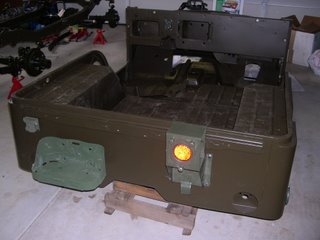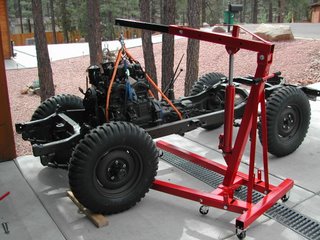First Start Viedo with sound
Click on the "First Start Video" link on the right side of this page to see and hear the first crank up.
This is the story and photos of my Jeep rebuild over a two year period.
Click on the "First Start Video" link on the right side of this page to see and hear the first crank up.

This week the engine was stated up for the first time! It put out some smoke, and the new paint on some parts burned off, but it ran great. After 15 minutes of running, I shut it down to re-torque bolts, check valve clearances, timing, etc.
I had one problem with the oil pressure gauge. So I installed an old direct gague that I had in the garage to confirm that I really did have oil pressure. I figured out that the problem was the sending unit on the engine was bad. Not sending the right signal to the gauge on the dash. A new part is on the way from NY.
The rear seat frame arrived and has been painted. It is ready for the new seat cushions when they arrive. I have stated to install the front fenders (see photo) and horn, lights, etc. Not many loose parts lying around the garage left to put on the Jeep. The hood will be the last item after it gets painted with the big white Army star.
I have located some other old military items, such as ammo cans, that will be put in the Jeep for display. I will even have a Vietnam era flight suit with unit patches to wear when I drive the Jeep. Gotta look the part too!


It is now July 2006 and I am working on the Jeep almost every day. The radiator and grill are on and things are being connected to the engine, the gauges on the dash, and to the brake and clutch pedals. The Jeep has been converted back to the original 24 volt electrical system, which has a Generator.



The body, fenders and all small parts have been sandblasted, primed and painted. Now it is time to put the body, or "tub" back on the frame. Before the tub was put on, the new electrical harness, fuel and brake lines and other things that go "under the floor" were installed.
The drive shafts got new U joints. One was bent and required a new end be welded on by a local drive line shop that could do the proper alignment.
Even though it is starting to look like a Jeep again, there are hundreds of things still to do. Almost daily trips to Ace Hardware looking for bolts, nuts and screws. Many of the old bolts were too rusty to clean up and use.
Notice that some parts are a different OD green. As I buy parts, some come with the old World War II color, some come with the Korea War color. Those that don't match, are cleaned up, sanded and repainted with the correct Army OD color. Right down to each nut, bolt and screw.



A big step was getting the new tires and tubes installed so that I now had a "rolling chassis". Next, the overhauled engine/transmission package is put back into the frame.
The date is now June of 2006. Of course we were on the sailboat for 9 months, so not much happened with the project as it sat in the garage collecting dust until this spring.



More disassembly and getting a list together of parts that will be needed later. At this point, I had purchased several military Technical Manuals and Parts Manuals to help with the project. The military is great at creating detailed manuals with plenty of pictures and drawings. You just need to learn to read the "military way".
For example, in one of the manuals you want to look up the part number for the bracket that supports the generator. You go to the index and look for; Brackets, End, generator in section 0601.1 where you will find the original Willys-Overland part number, WO-118835. Confusing at first, but once you fumble around the books, it starts to make sense.
Here are some more photos of the Jeep as it came apart. Oh, the yellow paint came from Mr. Favro, the former owner, who worked for Catipillar in Phoenix, so he used the same yellow paint you might see on a bulldozer.
Here is a photo of the Jeep as it looked when I found it sitting under a tree. It was just down the street from our house in Show Low. I had driven by and looked at it for many months. Then one day I stopped and asked the lady that answered the door if the Jeep was for sale. She said her husband should sell it, as it did not run and he had no need for it now.
I came back a few days later and talked to Mr. Favro and he agreed to sell it to me. I first wanted to have a friend, who knows Jeeps, look it over and tell me what it was worth. That is when I figurd out that it was really an ex-military Jeep, built in 1953. I had thought it would be fun to have a Jeep, something to fix up and drive. Now, it became a military restoration project!
We agreed on a price of $1700, and I towed it home December 20, 2004.